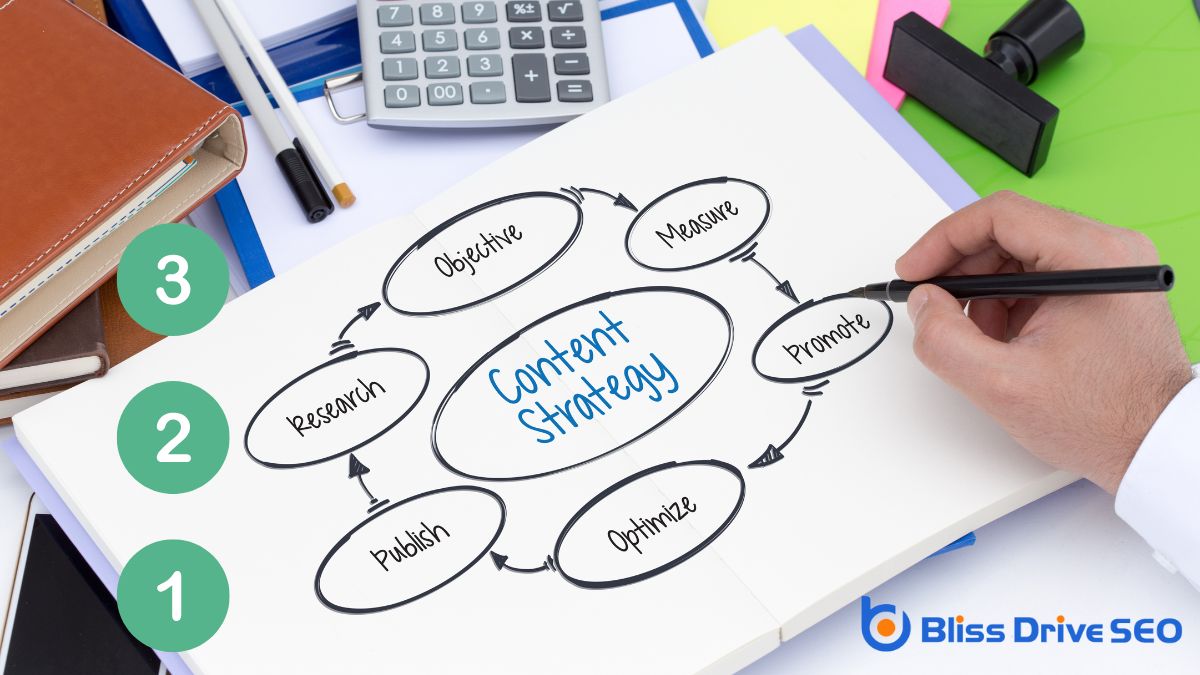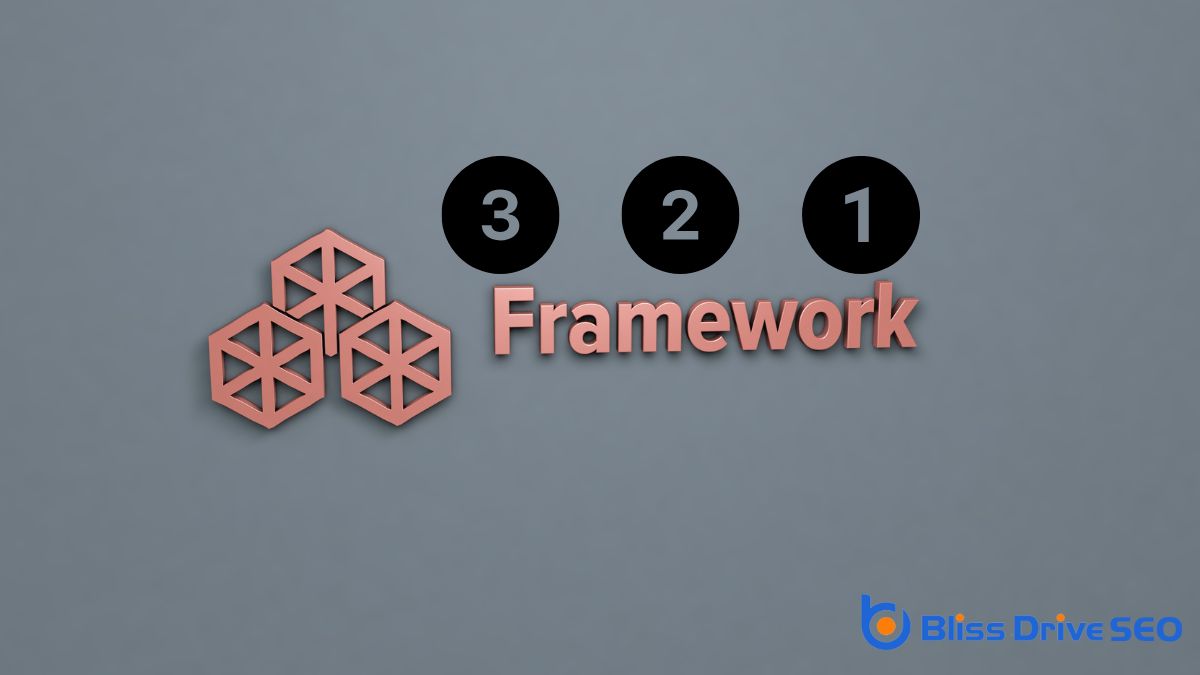Digital Marketing Services
Learn More About Us

The 3-2-1 content strategyA plan for creating, publishing, and managing content to meet business goals. is your blueprint for crafting engaging, authoritative, and promotional content. It balances three types of content: informative pieces that build authority and trust, engaging content that fosters interaction, and promotional content that highlights the benefits of your products or services. This structured approach guarantees you provide valuable insights, connect emotionally with your audience, and use effective calls to action. By selecting the right formats and honing your core message, you enhance audience engagementThe interactions that users have with a brand’s content on social media. and brand loyaltyThe tendency of consumers to continue buying the same brand's products or services.. Ready to transform your content strategy into a well-oiled machine? There's more to explore on how you can adapt it for success.

Understanding the 3-2-1 framework is crucial for crafting a successful content strategy. You want to ensure your content stands out and resonates with your audience. The 3-2-1 framework helps you balance different types of content in a structured way, making your strategy more effective and organized. By following this framework, you'll manage your content creation process with greater ease and clarity.
First, you need to grasp the principle behind the numbers. The "3" in the framework represents the majority of your content, usually informative or educational pieces that provide value to your audience. These are the foundational elements that establish your credibility and authority in your field.
Next, the "2" signifies supportive content, which can include engaging or entertaining pieces that keep your audience interested and invested.
In your content strategy, you need to balance informative, engaging, and promotional content.
Focus on providing valuable insights with informative content to build trust with your audience.
Use engaging strategies to foster interaction and promotional techniques to highlight your products or services effectively.
When you're crafting a content strategy, focusing on informative content is key to engaging your audience and building authority. Informative content gives your audience valuable insights and practical knowledge, helping them solve problems or gain a deeper understanding of a topic. It's about teaching, explaining, or providing information that adds value to your audience's lives.
To create effective informative content, start by understanding your audience's needs, questions, and challenges. Immerse yourself in research to gather accurate and relevant data, ensuring your content is credible and trustworthy.
Structure your content clearly, using headings, bullet points, or lists to break down complex information into digestible parts. This approach makes it easier for your audience to absorb and retain the information you're providing.
Incorporate visuals like infographicsVisual representations of information, data, or knowledge intended to present complex information qu..., charts, or diagrams to enhance understanding and maintain interest. These elements can simplify complex topics and make your content more engaging. Always aim to provide actionable insights or useful tips that your audience can apply immediately.
While informative content lays the foundation for a strong content strategy, it's equally important to make sure your audience stays engaged. To achieve this, focus on three types of engaging content: interactive, storytelling, and user-generated.
Interactive contentContent that requires user interaction, such as quizzes, polls, or calculators., like quizzes and polls, invites your audience to participate actively rather than passively consuming information. This not only keeps them engaged but also provides you with valuable insights. For example, a quiz about product preferences can guide your future offerings.
Storytelling, on the other hand, connects emotionally with your audience. By weaving narratives around your brand or its values, you create a memorable experience. People tend to remember storiesA feature on platforms like Instagram and Facebook where users can post photos and videos that disap... more than facts, so use storytelling to make your message stick. For instance, share a customer success story that highlights how your product made a difference.
Lastly, user-generated content fosters community and trust. Encourage your audience to share their experiences with your brand, whether it's through reviews, photos, or videos. Featuring this content on your platforms not only boosts engagement but also authenticates your brand's value. People trust other people, so let your audience's voices amplify your reach and credibility.
Promotional content plays a crucial role in capturing your audience's attention and driving action. To create effective promotional content, focus on three key techniques: storytelling, exclusive offers, and clear calls to action.
Storytelling helps you connect emotionally with your audience, making your product or service more relatable. By sharing authentic stories, you build trust and encourage your audience to see the value in what you offerThe specific product or service being promoted by affiliates..
Craft exclusive offers that create urgency and entice your audience to act quickly. Limited-time discounts or special promotions can effectively boost engagement and conversions. Guarantee these offers are clear and accessible, so potential customers understand the benefits without confusion.
Crafting a captivating content strategy involves selecting formats that resonate with your audience and enhance engagement. When you're choosing two effective formats, it's essential to think about what best fits your brand and audience preferences. Here's a simple approach to help you decide:
Choosing the right formats is only part of constructing an effective content strategy; the next step is defining your core message. This message is the essence of what you want your audience to understand and remember. It's essential to identify what you stand for and what makes your brand unique. Reflect on your values, mission, and the specific problems your product or service solves. Keep it simple and verify it aligns with your audience's needs and interests.
Start by asking yourself: What do you want your audience to feel or do after engaging with your content? The answer should guide your message. Avoid jargon and stay authentic; your audience connects better with genuine and straightforward communication.
Also, make sure your message is consistent across all formats you've chosen. This consistency helps build trust and reinforces your brand identityThe visible elements of a brand, such as color, design, and logo, that identify and distinguish the ....
Always test your core message with your audience. Gather feedback and be open to adjustments. Your message should evolve based on the feedback and changing market conditions while staying true to your brand's essence.
By adopting the 3-2-1 approach, you'll see improved audience engagement as your content directly targets your audience's interests. This method encourages diverse content formats, keeping your audience intrigued and coming back for more.
As a result, you enhance brand loyalty by consistently meeting and exceeding your audience's expectations.
A well-executed 3-2-1 content strategy greatly boosts audience engagement by offering a balanced mix of content that caters to varying preferences. By using this approach, you make sure that your audience doesn't lose interest and keeps coming back for more. Here's how the strategy works to improve engagement:
Frequently, the success of a 3-2-1 content strategy hinges on embracing diverse content formats. When you diversify your content, you cater to the varied preferences of your audience. Some people love reading in-depth articles, while others prefer quick, engaging videos or eye-catching infographics. By offering a mix, you make sure that you're reaching as many individuals as possible in ways that resonate with them.
Diverse formats also allow you to present information in the most effective manner. Complex data can be simplified through infographics, while personal stories might be more impactful in a podcast or video. This flexibility in presentation not only makes your content more accessible but also increases its shareability. People are more likely to share content that's easy to digest, visually appealing, or emotionally engaging.
Moreover, by experimenting with different formats, you can discover what works best for your brand and audience. This experimentation can leadA potential customer referred by an affiliate who has shown interest in the product or service but h... to insights about your audience's behavior and preferences, enabling you to refine your strategy further. Embracing diverse content formats not only enhances audience engagement but also maximizes the reach and impact of your messaging.
Embracing diverse content formats naturally leads to enhanced brand loyalty under the 3-2-1 approach. By engaging with your audience in various ways, you create a richer, more personalized experience. This approach isn't just about mixing media; it's about fostering trust and connection. When customers feel understood, they're more likely to stay loyal to your brand. Here's how the 3-2-1 strategy can boost brand loyalty:
Creating content with purpose means delivering value and intention behind every piece you produce. You need to focus on what your audience truly needs and how you can help them solve their problems. Start by identifying your audience's pain points and interests. Understand their journey and where your content fits within it. This approach guarantees you're not just creating content for content's sake but providing meaningful solutions.
When crafting purposeful content, clarity is key. Use straightforward language and avoid jargon that might confuse your audience. Your message should be easily understood and actionable. Think about the specific goal of each piece of content. Are you aiming to inform, entertain, or persuade? Knowing this will guide the tone and structure of your content.
Consider using storytelling to engage your audience emotionally. Stories make information relatable and memorable. They help you connect on a deeper level, fostering trust and loyalty.
Additionally, always include a clear call to action that guides your audience on what to do next. Whether it's signing up for a newsletterA regularly distributed email containing news, updates, and content relevant to subscribers. or exploring further resources, your content should lead them toward a logical next step.
Before diving into execution, it's crucial to map out a clear plan for implementing your content strategy. The 3-2-1 approach requires precision, so you'll want to make sure each piece serves its purpose. Start by defining your goals—know what you want to achieve with each content type. Is it engagement, lead generationThe process of attracting and converting prospects into potential customers., or brand awarenessThe extent to which consumers are familiar with the qualities or image of a particular brand.? Once you've set your objectives, consider your audience's needs and preferences to tailor your content effectively.
To keep things structured, follow these steps:
When it comes to measuring success, you need to establish clear metrics that align with your initial goals. Begin by revisiting the objectives you set before implementing the 3-2-1 content strategy. Whether it's increasing engagement, driving traffic, or boosting conversions, your chosen metrics should reflect these aims.
For instance, if your goal is to enhance engagement, track likes, comments, and shares on your posts.
Use analytics toolsSoftware used to track and analyze website performance, user behavior, and marketing efforts. to gather data, providing insights into your content's performance. Google AnalyticsA web analytics service offered by Google that tracks and reports website traffic., social media insights, and email marketingThe use of email to promote products or services, build relationships with potential customers, and ... reports offer valuable information about audience behavior and content effectiveness. These tools help you identify trends and adjust your strategy accordingly.
Consider setting up a regular review process to assess your progress. Monthly or quarterly evaluations can highlight areas of success and those needing improvement. Compare your results against industry benchmarks to see how you stack up.
Don't forget to celebrate your achievements, even small ones, as they indicate you're on the right path.

Tailoring the 3-2-1 content strategy to your brand's unique identity is crucial for achieving meaningful results. This approach isn't one-size-fits-all, so think about your brand's personality, audience, and goals. Start by identifying what makes your brand distinctive. Is it your voice, values, or the way you engage with your audience? Understanding these elements will help you adapt the strategy effectively.
Here are three steps to make it work for your brand:
By embracing the 3-2-1 content strategy, you can effectively streamline your content creation process. Focus on three types of content, select two engaging formats, and define your core message to guarantee your brand's voice is clear and consistent. This approach helps you craft purposeful content, implement strategies efficiently, and measure success accurately. Adapt the strategy to fit your brand's unique needs, and you'll see improved engagement and stronger connections with your audience.
